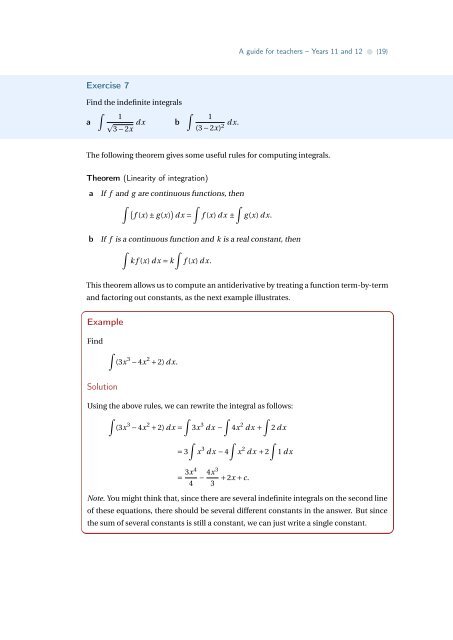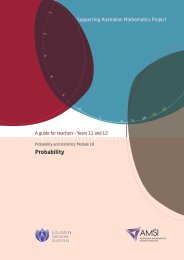Integration - the Australian Mathematical Sciences Institute
Integration - the Australian Mathematical Sciences Institute
Integration - the Australian Mathematical Sciences Institute
You also want an ePaper? Increase the reach of your titles
YUMPU automatically turns print PDFs into web optimized ePapers that Google loves.
A guide for teachers – Years 11 and 12 • {19}Exercise 7Find <strong>the</strong> indefinite integrals∫1a d x b3 − 2x∫1(3 − 2x) 2 d x.The following <strong>the</strong>orem gives some useful rules for computing integrals.Theorem (Linearity of integration)aIf f and g are continuous functions, <strong>the</strong>n∫ ∫∫(f )(x) ± g (x) d x = f (x) d x ± g (x) d x.bIf f is a continuous function and k is a real constant, <strong>the</strong>n∫∫k f (x) d x = k f (x) d x.This <strong>the</strong>orem allows us to compute an antiderivative by treating a function term-by-termand factoring out constants, as <strong>the</strong> next example illustrates.ExampleFind∫(3x 3 − 4x 2 + 2) d x.SolutionUsing <strong>the</strong> above rules, we can rewrite <strong>the</strong> integral as follows:∫∫ ∫ ∫(3x 3 − 4x 2 + 2) d x = 3x 3 d x − 4x 2 d x + 2 d x∫= 3∫x 3 d x − 4∫x 2 d x + 21 d x= 3x44 − 4x3 + 2x + c.3Note. You might think that, since <strong>the</strong>re are several indefinite integrals on <strong>the</strong> second lineof <strong>the</strong>se equations, <strong>the</strong>re should be several different constants in <strong>the</strong> answer. But since<strong>the</strong> sum of several constants is still a constant, we can just write a single constant.
















